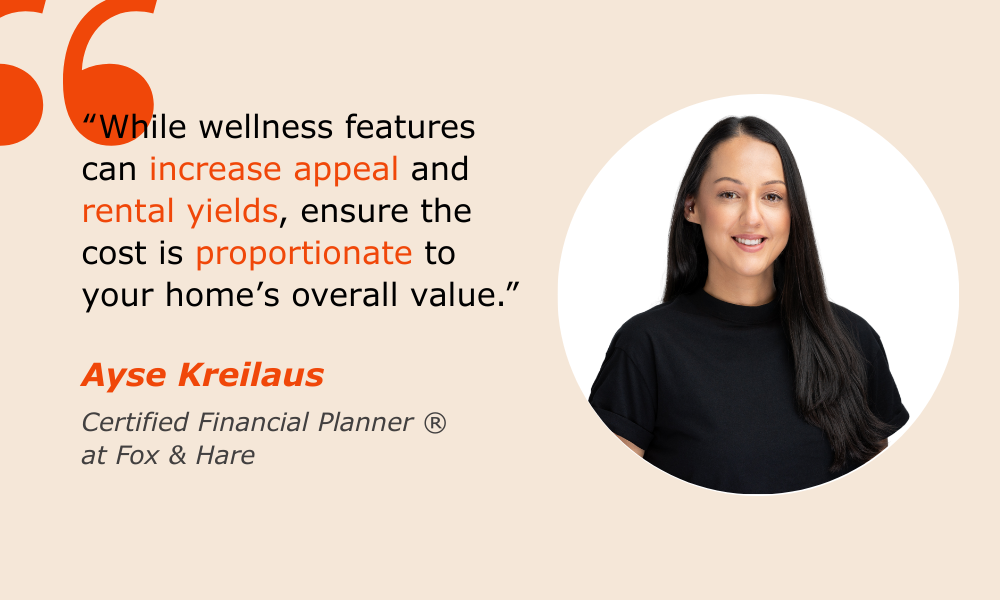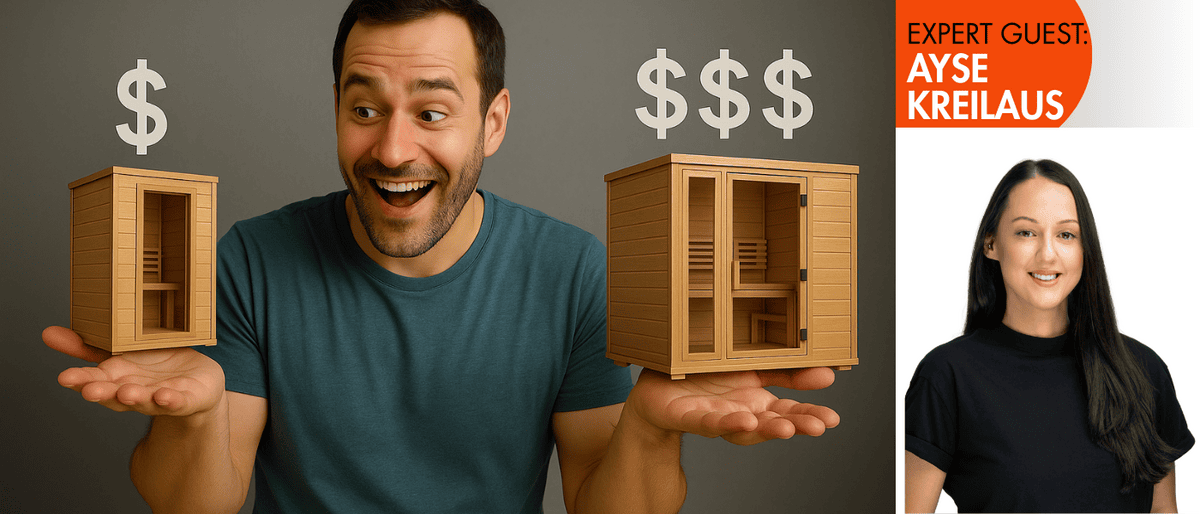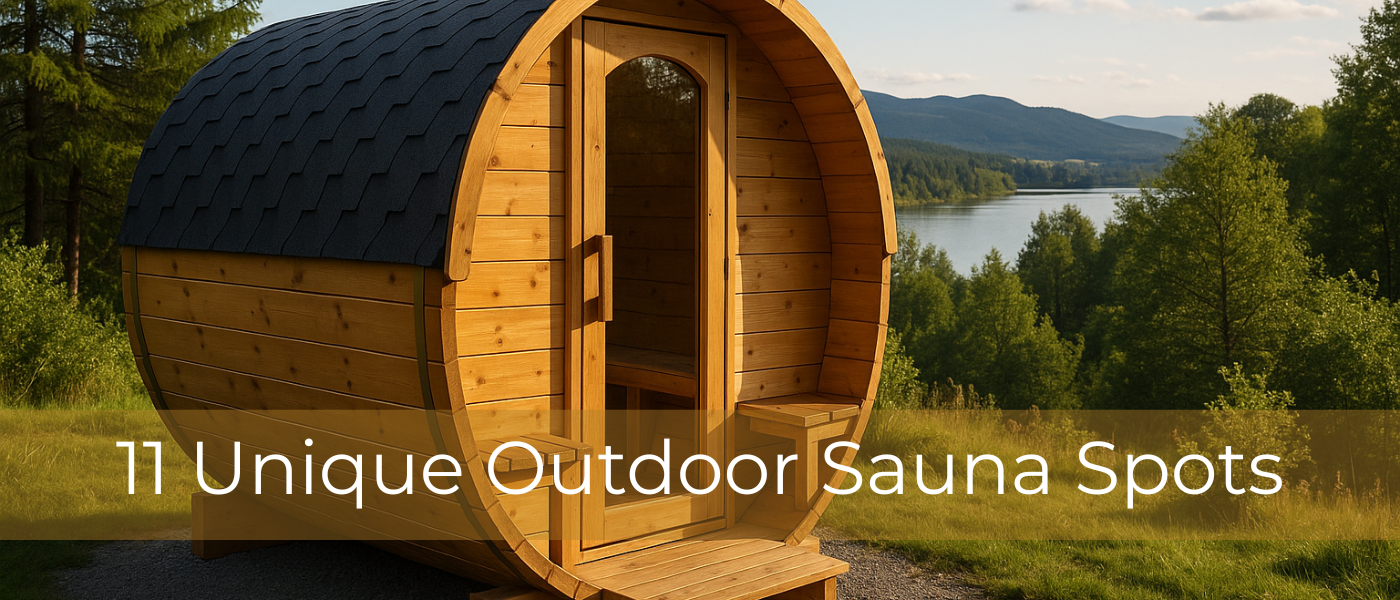Financial Advice provided by Ayse Kreilaus, Certified Financial Planner ®, Fox & Hare
Did you just come across a cheap sauna and think it’s a great renovation idea for your home? Before you click that ‘Order’ button, make sure you know how a home sauna impacts your property and finances now and in the years to come.
Home saunas are turning out to be a savvy financial investment. But is it right for you?
An entry-level home sauna priced at $10,000 can pay for itself within one year. For regular users, it may take just six months to hit ROI. It’s a wellness investment that truly deserves attention, especially since it has every potential to add to your property’s value in the long-term.
As more and more homeowners are opting to invest in wellness retreats they can enjoy at home, could this be a sign that adding a home sauna is also a sound financial investment for you? We asked Ayse Kreilaus, Certified Financial Planner ®, Fox & Hare, for guidance to know for sure if a home sauna suits you and your financial goals.
Shifting Home Values: Wellness at the Forefront
Modern homebuyers and renters are prioritising features that enrich their lifestyles. The traditional metrics of location and size have been joined by a rising demand for wellness-enhancing amenities. Recent research by SDS Australia shows that properties with saunas command 15% to 25% more in rental premiums.
In premium coastal locations like Tamarama, rentals with sauna command up to $540 more than the typical weekly rental rate.
Cheap Sauna – Not: Calculating the Costs and Benefits
Set aside the wellness real estate trends for a while and ask yourself, “Does investing in a home sauna make a smart financial investment for me?”
“Buyers increasingly value features that enhance
their lifestyle and well-being”
Here are the top things for you to consider:
- Upfront and Additional Costs
While the sticker price for a cheap sauna may go as low as $3,000, or that of a mid-priced two-person sauna might hover between $8,000 and $15,000, the make, model, sauna type, and accessories can easily add up. Choosing a premium sauna comes with its perks but also with a heftier price tag. Apart from that, you should also consider the cost of installation, fees to secure council approvals, and electrical upgrades. - Maintenance Costs
Home saunas can last up to 15 years and over, depending on quality, frequency of use and upkeep. To get the most out of your home sauna’s performance and value, you should budget for maintenance over the next decade or so. As for additional energy usage, expect to add $10 to $30 on top of your current power bill depending on the sauna type you’ll choose. - Payback Period and ROI
Based on research by SDS Australia, a $10,000 sauna can recoup its cost in only 91 two-hour sessions—that is, equivalent to approximately one year for a regular sauna goer. For couples or households that use it more often, the break-even point can be reached in just six months. Every session you enjoy in your home sauna equates to instant savings. Needless to mention, it also redounds to a step up your future health and wellness which is an investment in itself! - Impact on Property Value
In wellness-focused markets, such features can significantly enhance both rental income and buyer interest, up to 15% based on SDS Australia estimates. However, you must also think about the following:- Is the cost of getting a home sauna upgrade proportionate to your home’s overall value? Spending too much on a single feature might not yield a full return upon sale. A general guideline is to keep luxury upgrades within 10-15% of your property’s market value.
- Does a sauna align with buyer expectations in your specific area? Consult local real estate agents and look at recent sales of comparable properties to gauge demand. Premium features deliver the best returns where buyers actively seek them, which means a cheap sauna might not be your best choice.
- Are you planning to resell your property? Research suggests high-quality installations might recoup 50-85% of their cost when you sell, but this varies greatly depending on the market and the quality of the work. Keep all receipts and certifications.
- How often will you be using your home sauna investment? Think about the ‘wellness return’ you’ll derive by using it. A $15,000 sauna used three times a week for eight years works out to roughly $12 per session only! That’s significantly cheaper than visiting a commercial spa.
Financing Your Home Sauna Upgrade
If you plan to borrow for this upgrade, consider the following tips to maintain a balanced financial strategy:
- Follow Smart Borrowing Practices
Aim to keep your total home loans below 80% of your property’s value. This helps avoid extra Lender’s Mortgage Insurance and often secures better interest rates. - Match the Loan Term
Consider financing the sauna over its expected lifespan (perhaps 15-20 years) rather than rolling it into a standard 30-year mortgage term. - Ensure Affordability
Make sure you can comfortably manage the repayments, ideally keeping them below 30% of your household income, even if interest rates rise by a few percent.

Balancing Lifestyle Goals with Financial Growth
Investing in a home sauna is as much about enhancing your quality of life as it is about the financial returns. It’s a delicate balance that a cheap sauna in the market may not be able to help you achieve. In fact, you’d want to buy a home sauna for intangible benefits — for your personal enjoyment and potential future returns.
A few considerations you should make to balance your lifestyle and finances include:
- Prioritise Long-Term Growth
Many financial planners advise directing the majority (e.g., 70%) of your investment capital towards growth assets like superannuation, managed funds, or shares before allocating significant amounts to lifestyle enhancements. - Consider the ‘Opportunity Cost’ of getting a home sauna
What else could the money spent on a sauna achieve? For example, $25,000 invested elsewhere could potentially grow substantially over 20 years. Understanding this trade-off helps inform your decision. - Maintain a Safety Net
Before committing funds to discretionary upgrades, ensure you have an emergency fund covering 3-6 months of essential living expenses.
“Make sure you can comfortably manage the repayments,
ideally keeping them below 30% of your household income”
Is a Cheap Sauna a Sound Investment?
Beyond the price tag lies a host of financial, wellness, and lifestyle benefits that can transform your daily routine and boost your property’s appeal. Whether you’re looking to enhance your well-being or capture higher rental yields, or both, a home sauna stands out as a smart and rewarding upgrade.
But, the final decision on whether to get a home sauna or not cannot simply be based on the cheapest sauna you can find.
You should be aware of all the financial considerations that come with owning a home sauna. Take a calculated financial decision by weighing your ability to finance this home upgrade alongside examining your long-term financial goals.
Talk to an expert. Contact SDS Australia
Disclaimer:
This article is intended for informational purposes only. Market conditions, financial figures, and regulations may evolve over time. Always consult with qualified financial, property, and tax professionals for personalised advice before making any significant investment decisions.
Figures and projections are derived from analyses similar to those conducted by SDS Australia and industry benchmarks. Past performance is not indicative of future results.
References & Technical Notes:
1. Property valuation metrics derived from CoreLogic data (Q1 2024) and Australian Property Institute principles regarding luxury improvement returns.
2. Lending parameters align with APRA serviceability assessment frameworks and current prudential standards for ADIs.
3. Investment growth projections based on S&P/ASX 200 Total Return Index historical performance (10-year trailing average to December 2023). Past performance is not indicative of future results.
4. Capital recovery ranges for premium residential improvements sourced from Herron Todd White national property reports and CoreLogic valuation data. Actual recovery is market-dependent.
5. Cost-per-use calculations employ standard financial amortisation methodology over projected asset lifespan
6. Tax treatment considerations subject to individual circumstances and current ATO rulings on capital improvements versus repairs and maintenance. Professional tax advice recommended.





